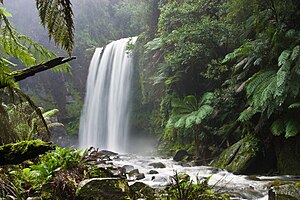 Image via WikipediaBy Sydney Ross Singer
Image via WikipediaBy Sydney Ross SingerChange is in the air - and in the sea and on the land. In fact, the entire planet is undergoing a transformation called climate change.
Temperatures will rise, along with humidity and the level of the oceans. Storms will be more severe, along with droughts and floods. Animals and plants and microorganisms will have to adapt to survive. Some species will not make it. Others will evolve and adapt to the new, changing ecosystem conditions.
However, despite all this change that is acknowledged and feared by governments throughout the world, there has been no change in the way we conserve our natural resources and protect endangered species.
The goal of modern conservation goes beyond protection of forests and wild spaces from development and pollution. Today's conservationists fight to protect and preserve native ecosystems and native species against "invasive" species. The goal is to return "invaded" ecosystems to their condition prior to the introductions of highly competitive "alien" species that have altered the environmental landscape. Essentially, conservationists and preservationists are resisting environmental change.
In the past, environmental managers introduced species into new environments to increase biodiversity and resource values of forests and other natural areas. They valued species for their ability to grow well in their new environments. Now, however, they call these thriving introduced species "invasive", and introduce insects, fungi, or other biocontrol pests to slow down their growth, or kill them with poisons, chainsaw, or bulldozers.
The hope is that by eliminating species that "don't belong" in a certain ecosystem, we can return that ecosystem to a more natural, balanced state where native species and endangered species can thrive without competition from introductions. However, climate change is a deal breaker for all conservation strategies.
Climate change means that native species that once thrived in past ecosystems may be threatened with extinction in the near future. Every species of plant, insect, mammal, bird, fungus, bacteria, and even virus will be impacted by these changes in the conditions of life. Native ecosystems existed in a different world of the past, with different conditions than we have today and will have tomorrow. Climate change means you can never go back to the way it was centuries ago. Today's and tomorrow's forests, coastal ecosystems, and oceans may not support yesterday's species. And this change is now fast upon us.
Changing conditions will lead to a rebalancing of the entire food chain. Some dominant species that preferred the old conditions will fall, and new species that thrive on the change will take their place. In short, this is a time of rapid evolution. It is a time to look forward, not backward.
As we assess species for their ability to survive and thrive in the new environmental conditions that are coming, we may discover that some species currently considered "invasive" for their ability to grow well are actually "invaluable" for being able to keep natural areas forested into the future, and our oceans vital and healthy.
The goal of environmental management should be to have healthy, vital ecosystems, regardless of the nativity of the species creating them. We cannot afford to attack introduced species for growing well and outcompeting native species. This ability to survive and thrive may make them invaluable in the future.
Those conservationists and preservationists who want to maintain native species and native ecosystems can fence, weed and manage areas that can serve as museums of the past biological world. But such natural preserve areas will require constant commitment of resources in an endless battle against the tide of climate change.
More importantly, we need to plant for the future, not weed for the past. We need to stop killing the fittest and saving the least fit, or the future forests will consist solely of weak and unhealthy trees. We need to value trees for growing well, and not just for being native, ensuring that we will still have forests to clean the air, remove carbon dioxide, and provide resources for man and wildlife as the climate changes.
Conservationism itself must change, evolving from an environmental philosophy that fights change into one that embraces and manages it.
The past is done. Climate change is now giving us a new world unfolding before our eyes. Either we fight the inevitable changes kicking and screaming for a lost past, or we plan for a better future by surfing the wave of change.
I say let's surf!
Sydney Ross Singer is a medical anthropologist and director of the Institute for the Study of Culturogenic Disease, located in Hawaii. His unique form of applied medical anthropology searches for the cultural/lifestyle causes of disease. His working assumption is that our bodies were made to be healthy, but our culture and the attitudes and behaviors it instills in us can get in the way of health. By eliminating these causes, the body is allowed to heal. Since most diseases of our time are caused by our culture/lifestyle, this approach has resulted in many original discoveries into the cause, and cure, of many common diseases. It also makes prevention possible by eliminating adverse lifestyle practices. Sydney works with his co-researcher and wife, Soma Grismaijer, and is the author of several groundbreaking health books.
Sydney Ross Singer and Soma Grismaijer can be reached at the Institute for the Study of Culturogenic Disease, P.O. Box 1880, Pahoa, Hawaii 96778 (808) 935-5563.
Article Source: http://EzineArticles.com/?expert=Sydney_Ross_Singer
http://EzineArticles.com/?How-Climate-Change-Can-Change-Conservation---From-Invasive-to-Invaluable&id=4851527

No comments:
Post a Comment